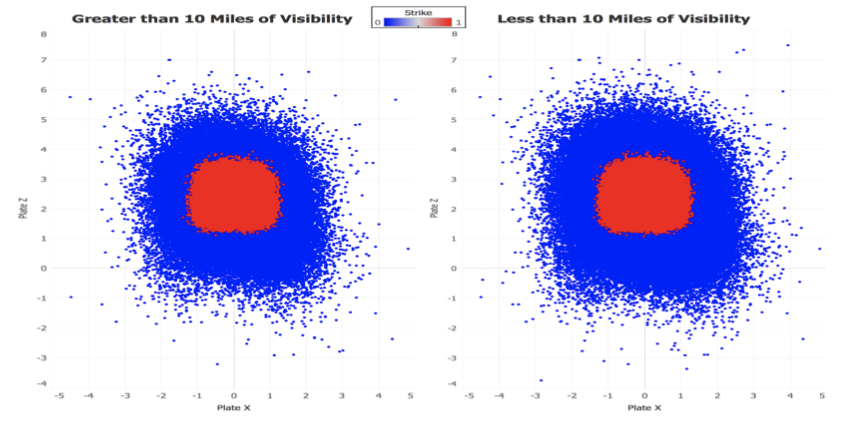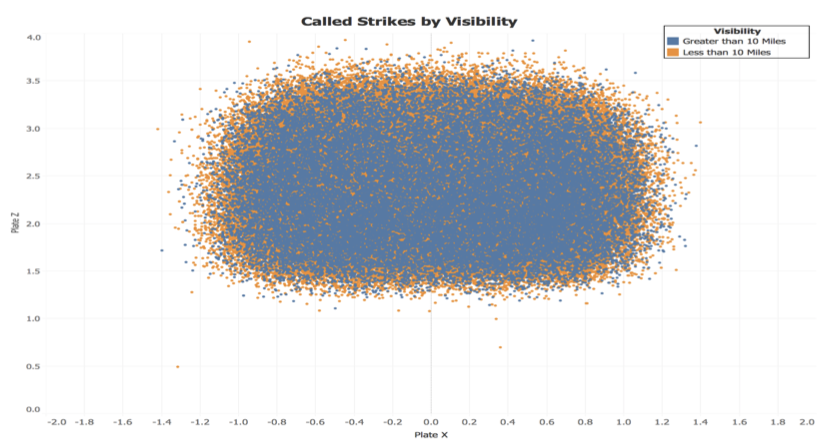By Evan Weiss
Abstract
For years baseball analytics researchers have been trying to learn more about the art of Catcher Framing. Catcher Framing is the process of making a borderline pitch appear to be strike, and it has proven to be an extremely valuable skill set. Previous research has been focused on looking at effect Umpires, the Count, and the Batter/Pitcher handedness has on called strike probability. This study uses the same modeling methodology that has been used in the past (Generalized Additive Model), but adds weather variables to the equation.
Modeling
To determine the impact the weather has on a catchers ability to make a borderline pitch look like a strike, we will model called strike probability.
Normally a regular logistic regression would be the optimal modeling technique; however, we can’t assume a linear relationship with all of our variables. Since a major predictor of the outcome of a pitch is the physical location of the pitch we need to use the x and y coordinate of where the ball crosses home plate in the model.
As a result, for this study a Generalized Additive Model (GAM) with a logistic regression link was used. Our dependent variable is whether or not the pitch was called a strike, and our smoothing term was the X,Y coordinate of where the ball crosses home plate. In addition, the model included an interaction variable of the count, batter handedness, and pitcher handedness. The model also included a dummy variable for the Homeplate Umpire for the game, as well as a dummy variable for the catcher. A Dome dummy variable was used for all games where the home team either played in a dome or had a retractable roof. Lastly, we included various weather related variables in the model.
Results
The model shows that there are some weather variables that have a significant impact on called strike probability.
The two weather variables that were statistically significant are the daily average cloud cover (significant on the 5% level) and the daily average
visibility (significant on the 1% level). Average cloud cover has a positive coefficient meaning that more cloud coverage increases the probability of a strike occurring. This makes sense considering the average visibility has a negative coefficient. These two results are telling the same story, which is that umpires are more likely to call a borderline pitch a strike when there is not a lot of visibility outside (i.e. on a foggy day).

| Variable | Coefficient | P-Value |
|---|---|---|
| Dome | 0.0068523 | 0.788604 |
| Average Temperature | 0.0047743 | 0.288552 |
| Average Dew Point Temperature | -0.0021793 | 0.611393 |
| Coldest Wind Chill | -0.0043657 | 0.135202 |
| Average Relative Humidity | -0.0005129 | 0.832650 |
| Average Wind Speed (MPH) | -0.0021178 | 0.457474 |
| Average Cloud Cover | 0.0008977 | 0.030146* |
| Average Visibility (Miles) | -0.0099258 | 0.004020** |
| Snowfall (Inches) | -0.0152478 | 0.814057 |
| Average Pressure (Inches) | 0.0507607 | 0.473124 |

Conclusion
There is evidence that the weather (specifically visibility) impacts the probability of a borderline pitch being called a strike. With that being said, there is evidence that a catchers ability to frame a pitch is impacted by the weather. Knowing that it is absolutely essential to factor in the air visibility when catcher framing analysis in the future.
Future Research
This research utilizes daily weather data. In the future, it would be beneficial to use by the hour weather data. In addition, for the dome dummy variable in the GAM model used, I included all stadiums with a retractable roof regardless if the roof was open or closed. It would be very beneficial to only include retractable roof stadiums in the dummy variable when the roof is closed.
In addition, it would be interesting to take a Bayesian approach to attack this problem.
Lastly, we need to find a way to incorporate these findings into the catcher framing aspect of the WAR calculation.
References
Willson Contreras working to improve pitch framing by refining his skills as a ‘receiver’
By Mark Gonzales, Chicago Tribune |FEB 27, 2018 AT 7:35 PM.
Creating a Game Score Database
By Jim Albert on September 21, 2020.
Regression Models in R: Generalized Additive Models
DataScience, DataScience, Tutorials, Online Courses in R | Published on July 6, 2017.
Probabilistic Pitch Framing (part 1)
By The Kudzu Kid, September 19, 2013.
Pitch-Framing Data Is Going Insane
By Jeff Sullivan, November 8, 2017.
WAR Update: Catcher Framing!
By David Appelman, March 20, 2019.
Framing and Blocking Pitches: A Regressed, Probabilistic Model: A New Method for Measuring Catcher Defense
By Dan Brooks and Harry Pavlidis, March 3, 2014.
Contact
Evan Weiss
Syracuse University
Email: eweis100@syr.edu
Phone: 516-434-8040
